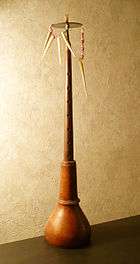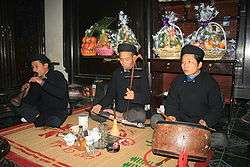Kèn bầu

The kèn bầu is one of several types of kèn, a double reed wind instrument used in the traditional music of Vietnam. It is similar in construction and sound to the Chinese suona and the Korean taepyeongso. It comes in various sizes and is a primary instrument of the music of the former royal court music of Huế.
Construction
The instrument has a conical hardwood body with seven finger holes. Unlike its Chinese and Korean counterparts, the kèn bầu has a detachable bell made of jackfruit wood, carved in the shape of a gourd (originally it was probably made out of an actual dried gourd, but wood is more durable). Into the playing end is fitted a small brass tube onto which a small double reed is placed.
Playing

The instrument's technique involves the use of circular breathing as well as a wide variety of ornamentation including wide vibrato and sliding tones.
Etymology
Kèn means oboe and bầu means gourd, referring to the instrument's bell. The Vietnamese monochord zither called đàn bầu, which also formerly had a gourd as part of its construction, shares the use of this word in its name.
Performers
One of the most prominent kèn bầu players is Trần Thảo, who leads the nhã nhạc (royal music) group of Hue and has toured internationally. He is part of a hereditary lineage of court musicians.